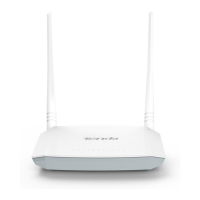72
When the interface is set to a WAN interface, the gateway IP address should be in the same
network segment as that of that of WAN port. When the interface is set to a LAN interface, the
gateway IP address should be in the same network segment as that of the LAN port.
If you are not familiar with static IP, you’d better not configure this function. Unreasonable static
routes may cause fault to the network.
4.12.3 RIP
RIP (Routing Information Protocol) is one of the oldest distance-vector routing protocols which employ the hop
count as a routing metric. RIP prevents routing loops by implementing a limit on the number of hops allowed in a
path from source to destination. The maximum number of hops allowed for RIP is 15, which limits the size of
networks that RIP can support. A hop count of 16 is considered an infinite distance and the route is considered
unreachable.
Choose Advanced > Advanced Setup > Routing > RIP to enter the configuration page.
It specifies two RIP versions the modem router supports: RIP 1 and RIP 2.
RIP 1: The periodic routing updates do not carry subnet information.
RIP 2: It included the ability to carry subnet information.
Active: The WAN interface sends and receives RIP packets.
Passive: The WAN interface only receives RIP packets.

